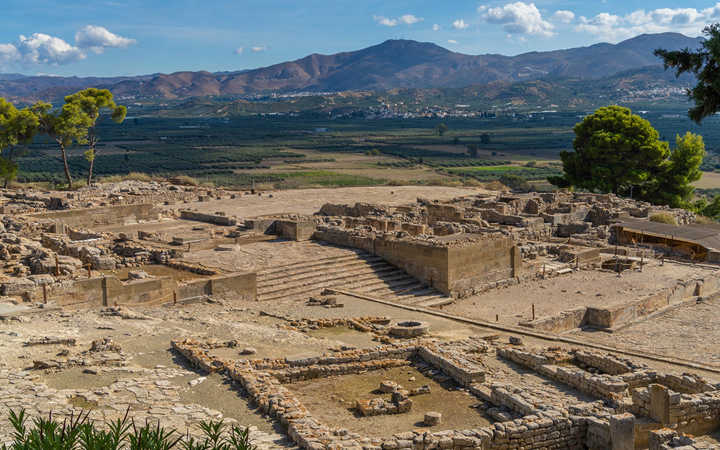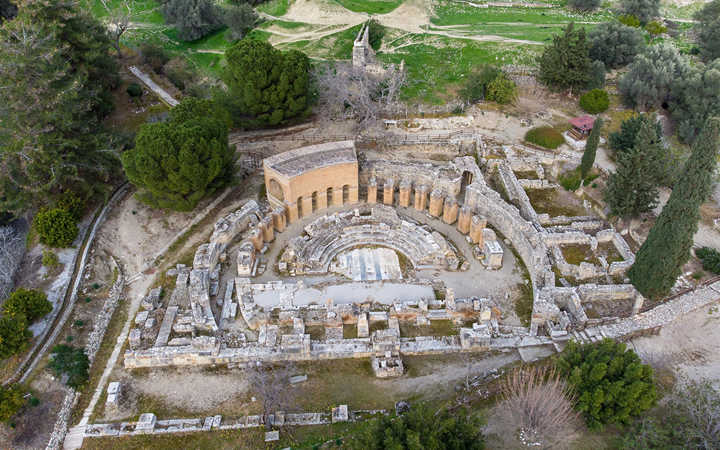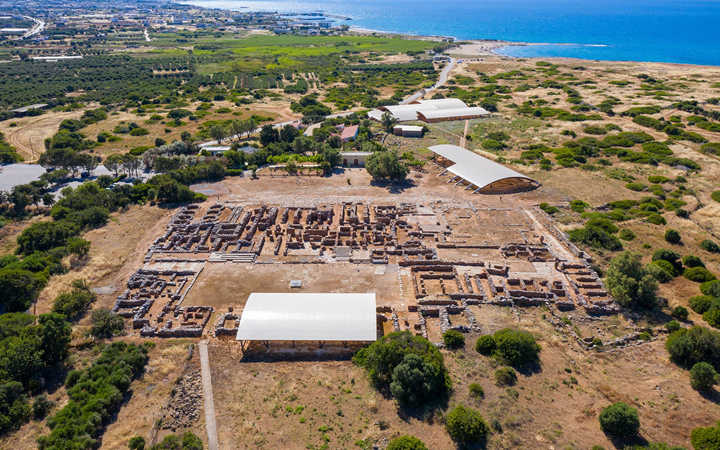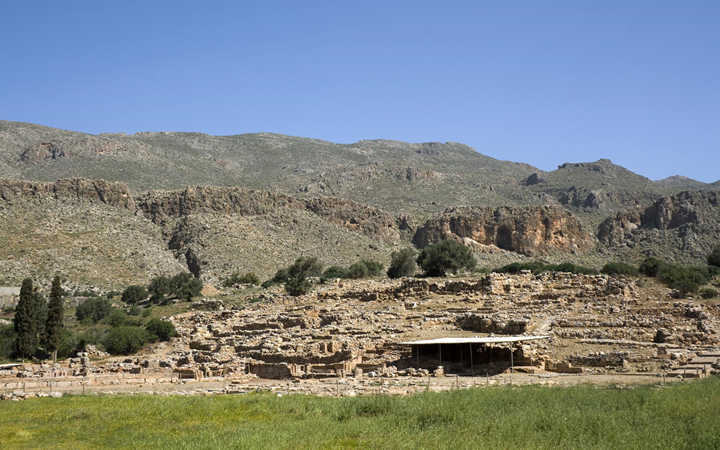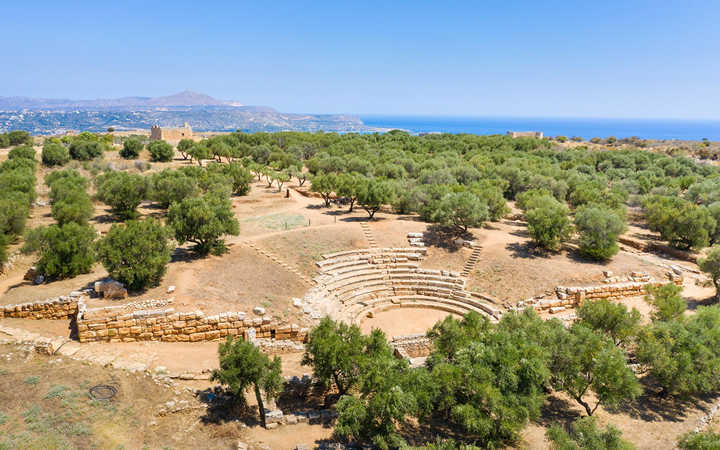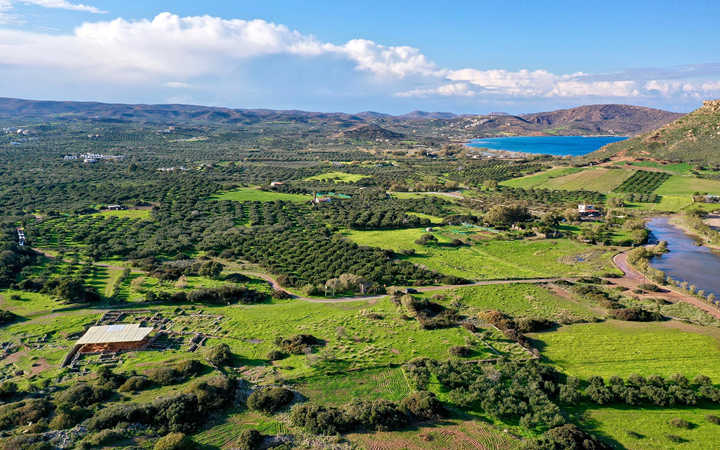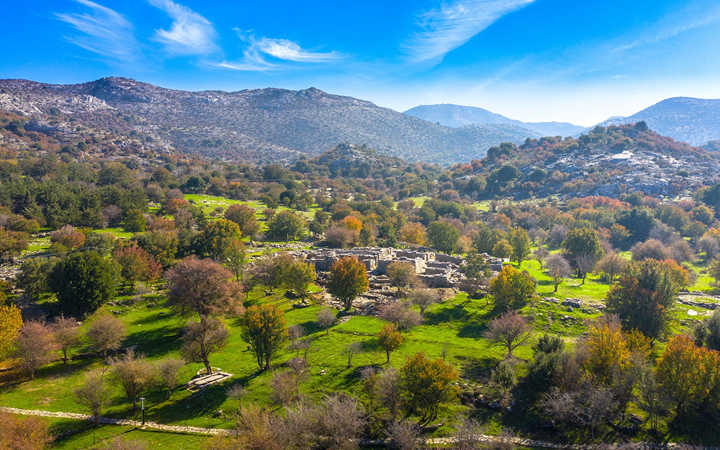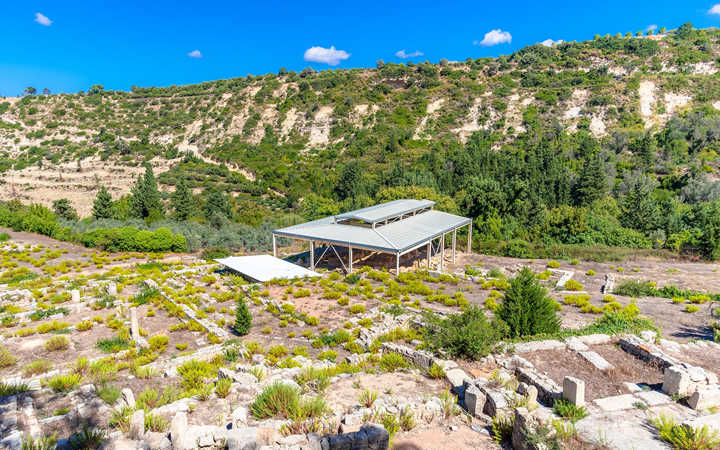The Minoans were a Cretan-based Bronze Age (3300-1200 BC) Mediterranean superpower which ruled their part of the world from the island of Crete from around 2000 BC for about 500 years. After that they came under the control of the Mycenaean Greeks and formed a hybrid culture with them for another 400 years, until about 1100 BC. Their center of power was Crete, and they left behind all kinds of artifacts and ruins on that island. Here are some of the most interesting.
1. Knossos
The city of Knossos was the principle population center of Minoan civilization, and the site of the largest Minoan Palace ever built. The original palace, located about 5.5 km south Heraklion, was built around 1900 BC. Knossos was the oldest European city, with a peak population (1700 BC) of 100,000 people. It had extensive trade relations with other population centers in the Mediterranean, and controlled the entire island of Crete. Home to the Labyrinth and the Minotaur, as well as Ikaros and his tragic death by flying too close to the sun, much of Knossos. Extensive ruins were excavated by Englishman Arthur Evans around 1900.
2. Phaistos
Ancient Phaistos is almost at the exact center point of the Crete's south coast. In mythology, the founder of Phaistos was Minos.
Its ports were Kommos and Matala. The Palace of Phaistos is Crete’s second largest after Knossos. Rival Gortyn destroyed Phaistos in the first century BC, but it rebuilt and remained an important population center until 300 AD. Phaistos participated in the Trojan war. Greek Historian Diodorus of Sicily writes that Phaistos, Knossos (Heraklion), and Kydonia (Chania), were the 3 main city-states of ancient Crete.
Phaistos is on an exposed hilltop and is best visited during the summer months in the cooler hours of the day, both either early morning or late afternoon.
3. Gortyn
Located in the center of Crete’s south coast, 10 km east of Phaistos, Gortyn is Crete's largest archeological site. Inhabited since 4,000 BC, Gortyn sat on a rise of land in the Messara Plain.
Gortyn gained ascendancy during the 1st millennium BC. Gortyn’s peak was during the Hellenistic Era (the last 3 centuries BC). From 67 to 828 AD, Gortyn was Crete’s capital.
The oldest example of ancient Greek law, dating from the mid-400's BC the Gortyn Code, carved in stone, was an electrifying discovery in the 19th century. 1km west of Gortyn, the Messara Archaeological Museum is stuffed with antiquities from Gortyn and the surrounding Messara Plain.
4. Malia
Thirty-seven km east of Heraklion, the Minoan Palace at Malia is Crete’s 3rd largest. It dates from 1900 BC, when immigration from the surrounding area- the Aegean Islands, the Greek mainland, Egypt, and the Cyclades- brought tradesmen and craftsmen, which led to commercial growth. The ruins are extensive and fascinating, including such points of interest as the Pillar Crypt, the Grand Staircase, and the famous kernos-a stone wheel lying flat on the ground with a hole in its center and 36 shallow depressions cut around its outer edge. Liquid libations- wine or oil- were probably poured into the center, while different grain and first fruit offerings were placed in the shallow depressions.
More about Minoan Palace of Malia
5. Palace at Zakros
This palace, found on Crete’s relatively short (33 km, north to south) east coast, is the smallest of Crete’s 4 excavated palaces (the others are Malia, Phaistos, and Knossos). The extent of the palace is a bit larger than an acre. Zakros traded with Cyprus, Egypt, and the Middle East.
On-site excavations started in the early 20th century, stopped, and resumed in the ‘60’s.
Since this is a recent excavation, more modern methodologies are being used, which results in better preservation. Because Zakros remained undiscovered for a long time, it was never looted.
Zakros is reachable by bus from Sitia, and the 45 km journey takes about an hour.
More about Minoan Palace of Zakros
6. Kydonia
Kydonia presents visitors with a twofer: it was built on the site of an already existing tourist destination in Crete, Chania. Its ruins in the Old Town of Chania.
Most of Ancient Kydonia can be found on Kastelli Hill. It was the third most powerful city-state in Crete during the Minoan era. It minted its own currency, with the image of mythical king Kydon on them. The ruins are near the Venetian Port. Unfortunately, most of ancient Kydonia is un-excavatable, as Chania has grown up on top of it. Be that as it may, objects have been unearthed dating to the Neolithic Age (10,00-2,000 BC). Many of these artifacts are preserved in the Archeological Museum of Chania.
7. Aptera
Aptera is an archeological site west of Chania about 15km. Its name means “wingless,” and comes from it being the mythological site of a defeat by the Muses over the Sirens, after which the Sirens lost their wings. Its defensible position made it an important city-state throughout the Minoan and Hellenistic rule (14th cent. BC-30 AD).
Leveled by an earthquake in the 7th century, a monastery was built there in the12th, closing in 1964. Situated on a scenic hill, surviving ruins include a 5th century BC temple, a Roman cistern and Roman baths, parts of various Doric-style temples, a Roman theatre, and a Roman villa.
8. Palekastro
Palekastro, an ancient Minoan (2700-1450 BC) settlement is situated on the northeast corner of Crete, gets its place name from the nearby modern town of that name, which itself means “Old Castle.” Situated a couple kilometers inland, it was the chief east coast port of the Minoan empire, with its nearby seaside harbors of Chiona and Kouremenos serving as the ports proper. (Many ancient port cities in the Mediterranean located themselves a bit inland to avoid direct attack from the sea.) These harbors provided excellent shelter from the relentless Meltemi winds blowing from the north all summer long, allowing merchant ships easier access to Crete than they otherwise would have, trying to land on the north coast of the island.
Palekastro is still being excavated, but archeologists are uncovering what was once a sprawling, busy city. Excavated homes on the city’s main street were large and comfortable, with evidence of a well-developed drainage system. This busy place ceased to exist, for all practical purposes, around 1400 or 1500 BC, as did most of Minoan Crete, probably because of the catastrophic eruption of the volcano at Thira (Santorini), 130 km (85 miles) to the north.
9. Zomynthos
Zomythos is on a plateau in the approximate center of Cree, in the northern foothills of Mt. Ida, Crete’s highest, on the path from Knossos to the north, to Idaion Atron, the sanctuary cave near Ida’s peak, where it is believed that Zeus was born and raised. Zomythos’ elevation is 1,200m (4,000 feet). It was recently discovered (1984). To date Zomythos is the only Minoan mountain settlement discovered and excavations are ongoing. Most notable is its extensive Minoan palace, which has yielded a number of interesting artefacts, such as a double-headed bronze ax used in worship, snake tubes (cylindrical vessels), and various vessels.
Archeologists speculate that Zomynthos served as a way station for pilgrims traveling to the sanctuary on the peak of Mt. Ida. Plata mentions the trip to the sanctuary in Plato’s Laws, Book I, saying that the distance from Knossos to the sanctuary is considerable, and that “doubtless there are shady places…which will protect us from the scorching sun.” Because of its high elevation, Zomynthos may have only served as a summer palace, as snow falls at the elevation during the winter months.
The palace at Zomynthos covers some 17,000 square feet, and the settlement is theorized to have been a religious, industrial, and administrative center. It is very well preserved, dating from nearly 4,000 years ago. It was discovered in 1982 by Professor Yannis Sakellarakis, who had been excavated near Ideon Cave, and a local shepherd told him about the area, calling it “Zominthos.” The name being pre-Hellenic, Sakellarakis decided to poke around, and discovered the ruins almost immediately.
Many of the uncovered artefacts can be found in the Archeological Museum of Rethymnon.
10. Lyttos
Lyttos, the oldest Dorian settlement in Crete, is built on the slopes of Mt. Dikti, Settled by Sparta around 1000 BC, its citizens were considered the bravest and strongest in Crete. Lyttos sent troops to the Trojan War.
It’s port was Milatos, near Malia, and Hersonissos. Lyttos was finally vanquished by Knossos after years of conflict, deserted, and left in ruins. Sparta rebuilt Lyttos. Later, rebuilt by Sparta, it regained importance, and prospered under later, Roman rule. The ruins, dating to the 7th century, BC, consist of terraced retaining walls with the walls of the citadel dating from the Roman period. Also surviving in part is Hadrian’s aqueduct.
11. Eleutherna
Eleutherna is an extensive archeological site with a new museum located on a spur of Mt. Ida, roughly in the center of Crete’s land mass. It thrived from around 1,000 BC until the Byzantine Era. Excavations have brought to light sanctuaries, necropoleis, and stone quarries, among others. It was settled by Dorian Greeks at a geographic crossroads.
Roman rule brought constructions of villas and baths, indicating its prosperous position in Cretan society. The city was damaged by earthquake in 365 BC, and following attacks by the Muslim Abbasid Empire and a second earthquake, was finally abandoned around 800 AD.
12. Ancient Polyrinia and Falasarna
Polyrinia, which has several alternate spellings in both Greek and English (such as Polyren, Polyrrhenia and Polyrrenion), was a city-state which ruled the entire western portion of Crete beginning in the 500’s BC. The name probably comes from the ancient Greek for “many sheep.”
The city itself was on a 370 meter (1220 feet) high promontory a few kilometers inland, in the northwest corner of the island. Its 6th century, BC founding puts it squarely in the Archaic Period (800-480 BC),which makes it a very old settlement indeed. For reference, however, this Period was well after Crete’s Minoan civilization, which collapsed around 1450 BC. Polyrinia’s ancient acropolis offers an extraordinary view of the surrounding area. It was the most significant city-state during this Period, except for Kydonia (modern Chania).
Falasarna served, on and off, as the port for Polyrinia.
Situated on the west coast 8 km (5 miles) from Polyrini, Falasarna was a fortified Hellenistic-era powerful seafaring city-state built to protect the sea routes to Italy and northern Africa. Falasarna’s harbor was excavated out of a lagoon, and has Phoenician elements in its construction. Its famous “throne of Falasarna” was likely dedicated to Astarte, Phoenician patroness of sailors.
At first Falasarna was subordinate to Polyrinia, but then land disputes between the two led to a hundred-year war. Despite this, it eventually continued to serve as Polyrrenia’s port into the Roman era, when one of history’s most powerful earthquakes in 365 AD elevated the entire city 6.5 meters up from the sea and destroying it in a tsunami. The city remained buried in mud for another 1600 years.
After the destruction of Falasarna, Kissamos, to the north, served as Polurinia’s port. There are no ruins at Kissamos, but there is an archeological museum.
Final Thoughts
Crete is one of those places, that it seems you only have to dig a little bit, and you uncover evidence of some ancient civilization.
There are lots of other places one can go on Crete for ancient archeology: Lyssos’ ancient port of Elyros, with its well-preserved amphitheatre, the sunken port of Olous in Elounda, the Minoan settlement of Gournia, mountain settlements at Kavousi, Vronda, Kastro and Azoria, the Doric city of Lato and the Doric cities of Ierapetra, Praisos, and Itanos, including their history of conflict with one another.
Crete still holds many unexcavated treasures. A good example of this is the ongoing work at the site of Crete’s new airport at Kastelli, Heraklion’s new airport, where a Minoan circular structure was uncovered in 2024 where a radar system was supposed to be installed. The radar system was put on hold until excavations could be completed, and will probably have to be located elsewhere.
If you love ancient history, and can visualize what life was like as you wander these ancient ruins, Crete can supply you with memories that last a lifetime.



